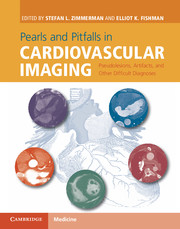 Pearls and Pitfalls in Cardiovascular Imaging
Pearls and Pitfalls in Cardiovascular Imaging Book contents
- Frontmatter
- Contents
- List of contributors
- Preface
- Section 1 Cardiac pseudotumors and other challenging diagnoses
- Section 2 Cardiac aneurysms and diverticula
- Section 3 Anatomic variants and congenital lesions
- Section 4 Coronary arteries
- Section 5 Pulmonary arteries
- Section 6 Cardiovascular MRI artifacts
- Case 47 Inappropriate inversion time selection for late gadolinium enhancement imaging
- Case 48 Pseudothrombus on dark blood images
- Case 49 Gibbs ringing artifact
- Case 50 Aliasing artifact in phase-contrast cardiac MR
- Case 51 Pseudostenoses on MR angiography from susceptibility artifact
- Case 52 Pseudostenosis on time-of-flight magnetic resonance angiography
- Case 53 Maki effect
- Section 7 Acute aorta and aortic aneurysms
- Section 8 Post-operative aorta
- Section 9 Mesenteric vascular
- Section 10 Peripheral vascular
- Section 11 Veins
- Index
- References
Case 53 - Maki effect
from Section 6 - Cardiovascular MRI artifacts
Published online by Cambridge University Press: 05 June 2015
- Frontmatter
- Contents
- List of contributors
- Preface
- Section 1 Cardiac pseudotumors and other challenging diagnoses
- Section 2 Cardiac aneurysms and diverticula
- Section 3 Anatomic variants and congenital lesions
- Section 4 Coronary arteries
- Section 5 Pulmonary arteries
- Section 6 Cardiovascular MRI artifacts
- Case 47 Inappropriate inversion time selection for late gadolinium enhancement imaging
- Case 48 Pseudothrombus on dark blood images
- Case 49 Gibbs ringing artifact
- Case 50 Aliasing artifact in phase-contrast cardiac MR
- Case 51 Pseudostenoses on MR angiography from susceptibility artifact
- Case 52 Pseudostenosis on time-of-flight magnetic resonance angiography
- Case 53 Maki effect
- Section 7 Acute aorta and aortic aneurysms
- Section 8 Post-operative aorta
- Section 9 Mesenteric vascular
- Section 10 Peripheral vascular
- Section 11 Veins
- Index
- References
Summary
Imaging description
“Maki” artifact or effect is named after Jeffrey H. Maki, MD, PhD, who first comprehensively described this as a “ringing” or “banding” artifact occurring in MRA studies (Figure 53.1). It manifests as lack of central arterial enhancement with parallel bands of decreasing hyperintensity in the location of the arterial walls. The proximal margin and the transition to normal arterial enhancement are gradual, without a sharply defined border. The effect is often most pronounced on subtracted images.
Importance
“Maki” artifact may be incorrectly diagnosed as arterial thrombosis, leading to inappropriate referral to invasive angiography. The artery exhibiting the artifact is not adequately imaged and underlying pathology such as thrombosis or dissection is not evaluated. Recognition of the artifact is important to adjust the clinical protocol to avoid too early acquisition of MRA images after bolus injection.
Typical clinical scenario
This artifact is observed in MR angiography studies if the center of k-space is acquired before the peak arterial contrast concentration has been reached. The leading edge of the bolus is typically narrow and enhancement is brisk, while the exact delay between injection and bolus arrival is influenced by multiple factors. These include cardiac output, the distance of the artery from the heart, vascular shunts, and stenoses. Optimal arterial enhancement is only achieved if the acquisition of the center of k-space occurs at the time of maximal arterial enhancement. Imaging too early will result in the Maki artifact, whereas imaging after the peak will decrease the signal-to-noise ratio and venous contamination will be more pronounced. The challenge of correct bolus timing is increased when a shorter contrast bolus is used to minimize the amount of contrast. Centric k-space encoding acquires the center of k-space first, allowing for the most precise bolus timing; however, it renders the MRA technique more prone to artifacts.
- Type
- Chapter
- Information
- Pearls and Pitfalls in Cardiovascular ImagingPseudolesions, Artifacts, and Other Difficult Diagnoses, pp. 168 - 170Publisher: Cambridge University PressPrint publication year: 2015
